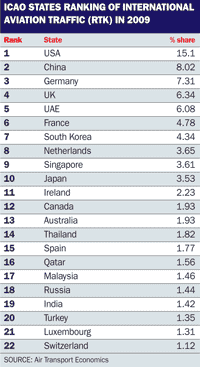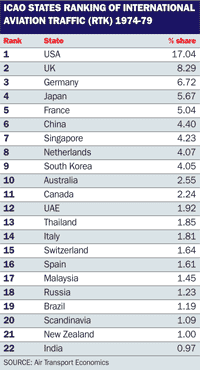No one pretended that getting ICAO's 190 member states with varying agendas to agree on a path to reduce carbon dioxide emissions from international aviation would be easy. "I must admit, and a number of you have witnessed it, that the assembly discussions were difficult," said ICAO secretary general Raymond Benjamin at the conclusion of the organisation's 37th assembly in October. "There were a number of divergent views on many aspects of the proposed resolution, but at the eleventh hour, we had a resolution."
 ICAO faced a challenge in getting consensus among its 190 member states on reducing emissions from international aviation. Picture: Rex Features |
|---|
But instead of creating a global scheme for emissions trading, ICAO opted to conduct a feasibility study to determine how to create the framework, and created 15 principles that member states should adhere to when developing and carrying out market-based measures to reduce emissions from aviation. The resulting framework is scheduled for review at ICAO's 38th assembly in 2013.
INTENSE NEGOTIATIONS "The non-binding resolution adopted by ICAO last month after two weeks of very intense negotiations was not as aggressive as the US and European negotiators had hoped," says Blakey. "Developing countries such as China and Brazil, on the other hand, felt the agreement should have given them more latitude to allow for their economic growth."
"The non-binding resolution adopted by ICAO last month after two weeks of very intense negotiations was not as aggressive as the US and European negotiators had hoped," says Blakey. "Developing countries such as China and Brazil, on the other hand, felt the agreement should have given them more latitude to allow for their economic growth."
One of ICAO's greatest challenges in creating its global emissions reduction framework is balancing the needs of developing and developed countries.
In its resolution on curbing greenhouse gases, ICAO said countries whose international aviation operations were 1% of total revenue tonne kilometres would be exempt from reporting environmental action plans to ICAO, and from market-based measures set at national, regional or local levels.
The problem is, about 168 ICAO member states fall below that threshold, and airlines in some of those countries are significant competitors to US carriers, says Nancy Young, vice-president of environmental affairs at the Air Transport Association (ATA) of America.
China, the United Arab Emirates, Qatar and Singapore are above the 1% delineation, while Brazil, Egypt and Italy fall below it.
The head of consultancy Air Transport Economics, Chris Lyle, describes the de minimis scheme as a moving target. Switzerland, which has traffic above the 1% target, could easily fall below the established threshold, while Brazil's traffic in the near future could rise above that level. In the resolution introduced in October, ICAO's council is required to review the thresholds by the end of 2011.
The European Union has formally "reserved" on the de minimis clause, which essentially means it has no intention of adhering to that portion of ICAO's guidelines.
In fact, it is business as usual for the EU to continue with its plans to fold aviation into its emissions trading scheme from 2012, eroding any hope that ICAO's development of an emissions reduction framework would persuade Europe to pull back on its plans to introduce the controversial trading programme.
EMISSIONS TRADING

EU commissioner for climate action Connie Hedegaard believes the ICAO resolution provides a good basis to proceed swiftly with the inclusion of aviation in emissions trading, and says the EU's plans are consistent with the 15 principles agreed in the resolution.
While ICAO urges states to engage in bilateral or multilateral consultations with other states to reach agreement on market-based measures, there is no call for mutual agreement, a concept that generated controversy at ICAO's 36th assembly in 2007.
The EU says emphatically that the ICAO resolution "can in no way be construed as requiring that market-based measures may be implemented only on the basis of mutual agreement between states".
As the EU remains firm in its belief that it has the authority to push forward with including aviation in its ETS, the USA is equally adamant that the EU's actions are illegal. The ATA and three of its members - American, Continental and United - are moving ahead with their legal challenge of the EU ETS.
The International Air Transport Association has joined the US association in opposing Europe's plans to expand ETS to include aviation, calling the unilateral move "misguided". IATA says more than 120 states at the ICAO assembly voiced objections to the EU ETS.
"We join them in believing that it is illegal under the Chicago convention and continue to work with the ATA on a court challenge," says IATA, which predicts that vocal opposition to the EU's plans will become stronger in the coming months.
Young believes the European Court of Justice should hand down its decision before the 2012 deadline of folding aviation into the EU ETS, and says a ruling is likely in late 2011.
The ATA's litigation, says Young, is another tactic to try to convince the EU to return to the negotiating table for the development of a global trading scheme developed by ICAO. But Lyle of Air Transport Economics points to a "lot of cynics" who say the EU Court of Justice tends to rule in favour of Europeans.
ICAO's challenge in getting consensus among its 190 states will be mirrored on a larger scale in December when the United Nations Framework Convention on Climate Change (UNFCCC) conference of parties meets in Cancun, Mexico to try to reach an agreement for curbing greenhouse emissions when the Kyoto protocol expires in 2012.
Expectations that the UNFCCC will achieve consensus on the post-Kyoto framework for managing greenhouse gases are low.
Ahead of the ICAO assembly, Benjamin concluded that the "likelihood that Cancun will produce something substantial is quite limited". Director of the Aviation Environment Federation Tim Johnson does not predict that a post-2012 framework will appear during the meeting in Cancun when the parties were "so far away" from reaching an agreement during the last UN climate change meeting in December 2009 in Copenhagen.
Aviation is unlikely to be a dominant topic in the negotiations, says Young. However, there are expectations that a high-level advisory group on climate change financing created by the UN earlier this year will recommend an aviation tax to fund initiatives for climate change adaptation.
Johnson says he understands the target is $100 billion a year. Young says the high-level group has operated in almost total secrecy since its creation after the Copenhagen meeting. Her understanding is that a lot of its work was "largely done in a vacuum", but she stresses that the group's recommendations are clearly just advice, and not actionable.
TAX
As ICAO attempts to overcome political challenges to develop global market-based measures, a tax would be an easier measure to implement, says Johnson.
He points to a cycle that needs to be broken of developing countries being wary of signing on to a global sectoral approach for aviation through ICAO until the UNFCCC develops its own climate agreement.
Highlighting the politics that dominated the ICAO assembly, Johnson believes that the UNFCCC needs to define the rules and parameters for climate change beyond 2012. Once that happens, ICAO can develop its framework for greenhouse gas emissions in a more definitive manner.
But noting the "high hopes and low expectations" for the UNFCCC meeting in Cancun, Johnson says that, realistically, any real movement on climate change "will be in limbo for a couple of years to come".
Source: Flight International



















